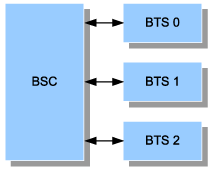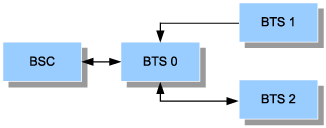This describes the BTS topologies. The BSC provides flexible BTS topologies on the Abis interface. These topologies are the star topology, chain topology, tree topology, and ring topology.
Star Topology
Star topology refers to the topology in which the BTSs connect to the BSC directly. These BTSs do not have lower-level BTSs. Star topology is a commonly used network topology.
Star topology features simple network structure, convenient capacity expansion, and high reliability. If a BTS incurs a fault, other BTSs are not affected. Therefore, the star topology is widely used. However, the transmission resources of the star topology cannot be fully utilized in small BTSs. In this case, the timeslot integration equipment can be used to optimize the utilization of transmission resources.
Figure 1 shows the star topology.
In the star topology, the Abis interface can use the TDM, IP, or HDLC transmission mode. For the relationship between the transmission mode and the topology, refer to Transmission and Networking on the Abis Interface.
Chain Topology
In the belt-shaped areas (such as highways) where the traffic volume is low, it is a waste of transmission resources to use the star topology. In this case, the chain topology can be used.
In the chain topology, a cascaded BTS processes the timeslots of itself and transparently transmits the timeslots of the lower-level BTSs.
The accuracy of clocks decreases when the number of cascading levels increases. Too many cascading levels deteriorate the BTS performance. Therefore, do not use the chain topology with excessive cascading levels. The BSC supports up to five levels of cascading BTSs. The chain topology has some disadvantages, such as inconvenient capacity expansion and low reliability. If the BTS in the middle of the chain incurs a fault, the lower-level BTSs are affected.
Figure 2 shows the chain topology.
In chain topology, the Abis interface can use the TDM or HDLC transmission mode. For the relationship between the transmission mode and the topology, refer to Transmission and Networking on the Abis Interface.
Tree Topology
In the tree topology, the BTS directly connecting to the BSC is the father BTS. All the children BTSs connect to the father BTS. The parent BTS performs timeslot switching for each child BTS. You can control the timeslot switching on the LMT.
The tree topology combines the features of star topology and chain topology. Its reliability is lower than the star topology but higher than the chain topology. The structure of the tree topology is complicated. Therefore, the capacity expansion and maintenance of the network is difficult.
Figure 3 shows the tree topology.
In tree topology, the Abis interface can use the TDM or HDLC transmission mode. For the relationship between the transmission mode and the topology, refer to Transmission and Networking on the Abis Interface.
Ring Topology
Ring topology is a special kind of chain topology. All the BTSs connect to each other to form a normal chain and the lowest-level BTS connects with the BSC to form a ring. The BSC supports up to five levels of cascading BTSs in a ring topology. If the communication of the ring is broken at a point, the topology of the BTSs before the breakpoint remains the same. After the breakpoint, the BTSs form a new chain connection in the reverse direction.
Therefore, two chains are formed and the BTSs can still offer services. This improves the robustness of the system.
Figure 4 shows the ring topology.
In ring topology, the Abis interface can use the TDM transmission mode. For details on the relation between the transmission mode and the topology, refer to Transmission and Networking on the Abis Interface.



